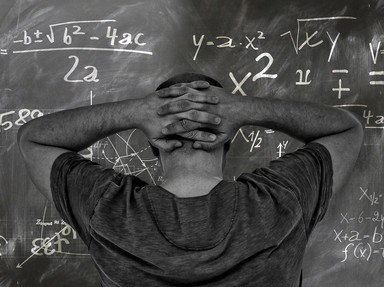Quiz Answer Key and Fun Facts
1. This mathematician said "Cogito, ergo sum". Translated into English, this is "I think, therefore I am". Who uttered these words?
2. A famous textbook, "The Elements", was still used as recently as the twentieth century. Who was the author of this text?
3. Many adults today regard Algebra as the least favoured section of their school mathematics. Who can we blame for early works leading to this dreaded subject, algebra?
4. When finding the circumference and the area of circles, we recall that this funny number 'pi' is used. Pi is a number which never ends, and in some schools is given as approximately 3.14 or in fraction form as 22/7. Who is credited with the first value for pi, as between 3 10/71 and 3 11/71?
5. Probably one of the most-remembered things about high school geometry is that one about the right-angled triangles, and that 'hypotenuse', and those other sides. If those sides are H for hypotenuse, A and B for the other sides, then A squared plus B squared equalled H squared. Who was it who wrote this relationship?
6. Most countries of the world have adopted the Metric System of measurement as their main or sole system of measurement. Who was one of the main people behind the metric system as far back as 1790?
7. Robert Boyle is credited with a Law which now bears his name. What is the main area with which this Law deals?
8. Albert Einstein was considered to be a prolific scientist, with work in several fields. Of the following areas of science, which is one in which Einstein is not famed?
9. The name Trinity has serious implications for humanity. What event in history caused this concern?
10. Today we rely on high speed computers for calculations. Who were two very early pioneers in the development of mechanical calculators?
Source: Author
DavidGordon
This quiz was reviewed by FunTrivia editor
Snowman before going online.
Any errors found in FunTrivia content are routinely corrected through our feedback system.

